STAR Offline QA Shift Histogram Description - Run 7
Note:
Not all reference plots may be ideal, be sure to carefully read the
descriptions.
This page contains the reference histograms and descriptions for the
Offline QA system for Run 7. These pages should correspond
exactly to the jobs viewed in the Offline QA Browser. However,
STAR is a dynamic experiment and the plots generated for QA will change
several times throughout the run. If this reference page seems
out-of-date, or if you find a job that would make a better reference,
please email the QA hypernews list here.
Other links:
Michael Daugherity for the QA Team.
May 10, 2007.
Page Index for QA Shift Plots
Page 1
Page 2
Page 3
Page 4
Page 5
Page 6
Page 7
Page 8
Page 9
Page 10
Page 11
Page 12
Page 13
Page 14
Page 15
Page 16
Page 17
Page 18
Page 19
Page 1
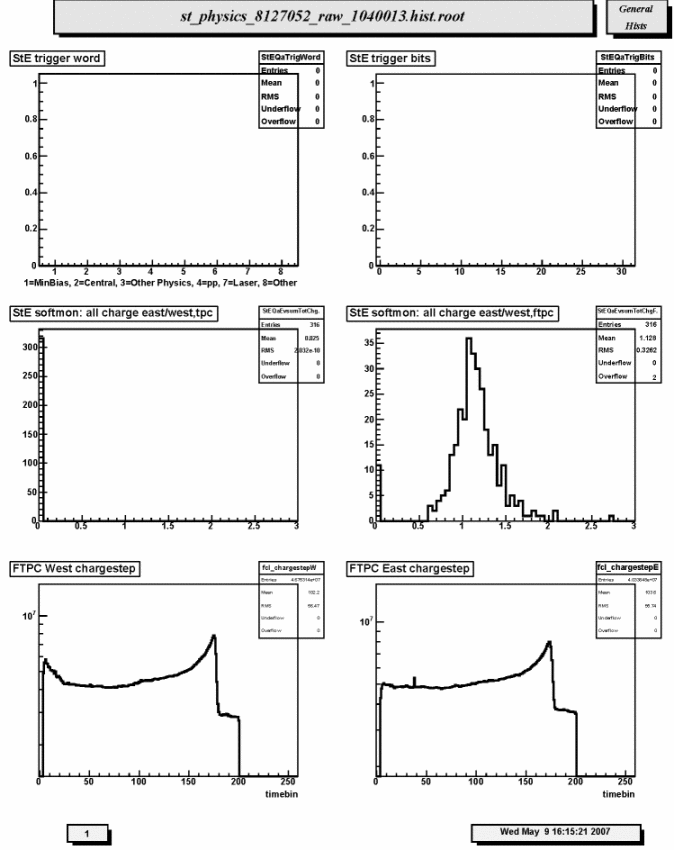
1. StE trigger word:
Distribution of trigger word groups: 1 = minimum bias, 2 = central,
3 = other physics, 4 = pp, 5 = high BEMC tower, 7 = laser, 8 = other.
2. StE trigger bits:
Frequency of usages of 32 trigger bits.
3. StE softmon: all charge east/west,tpc:
Ratio of total charge in all reconstructed clusters in TPC east to west halves. Should be peaked at ~1 with FWHM ~ 0.5.
4. StE softmon: all charge east/west,ftpc:
Ratio of total charge in all reconstructed clusters in FTPC East to West. Should be peaked at ~1.
5. FTPC West chargestep:
The real chargestep corresponds to the maximum drift time in FTPC West (clusters from inner radius electrode)
and is located near 170 timebins. This position will change slightly with atmospheric pressure. The hits beyond the step at timebin
170 are due to electronic noise and pileup. This step should always be visible even if it is only a "blip".
6. FTPC East chargestep:
The real chargestep corresponds to the maximum drift time in FTPC East (clusters from inner radius electrode)
and is located near 170 timebins. This position will change slightly with atmospheric pressure. The hits beyond the step at timebin 170 are due
to electronic noise and pileup. This step should always be visible even if it is only a "blip".
Page 2
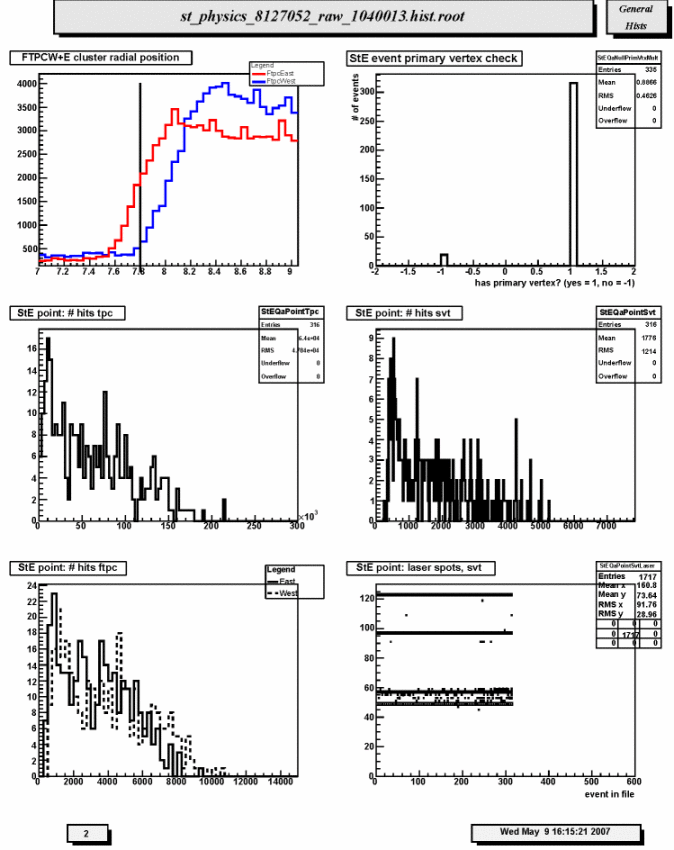
1. FTPCW+E cluster radial position:
The cluster radial position histogram for FTPC East(red) and FTPC West(blue) should show the
radius step at the inner radius (~7.8 cm). If the temperature and pressure corrections applied to the FTPC drift maps are correct,
the inflection point of the distribution of cluster radial positions will coincide with the black vertical line at 7.8 cm.
Deviations of more than 1mm (2 bins) should be reported.
2. StE event primary vertex check:
Primary vertex finding status for run; events with (1) and without (-1)
final vertex. The relative fraction of events with primary vertex
depends on trigger, beam diamond width and position.
3. StE point: # hits tpc :
Distribution of number of reconstructed space points in TPC per
event. Should scale with centrality, depends on multiplicity cut and trigger.
4. StE point: # hits svt :
Distribution of number of reconstructed space points in SVT per event.
Should scale with centrality, depends on multiplicity cut and trigger. Also depends strongly on vertex position distribution.
5. StE point: # hits ftpc:
Distribution of number of reconstructed space points in FTPC East (solid
line) and West (dashed line) per event. Should have similar means and
widths; scales with centrality, depends on multiplicity cut and trigger.
6. StE point: laser spots, svt :
Stability of laser spot positions in time bin (vertical axis) as
function of event number. The position of the laser spots should be
constant over time (event number), meaning that the SVT is in thermal
equilibrium. Four laser positions are shown.
Page 3
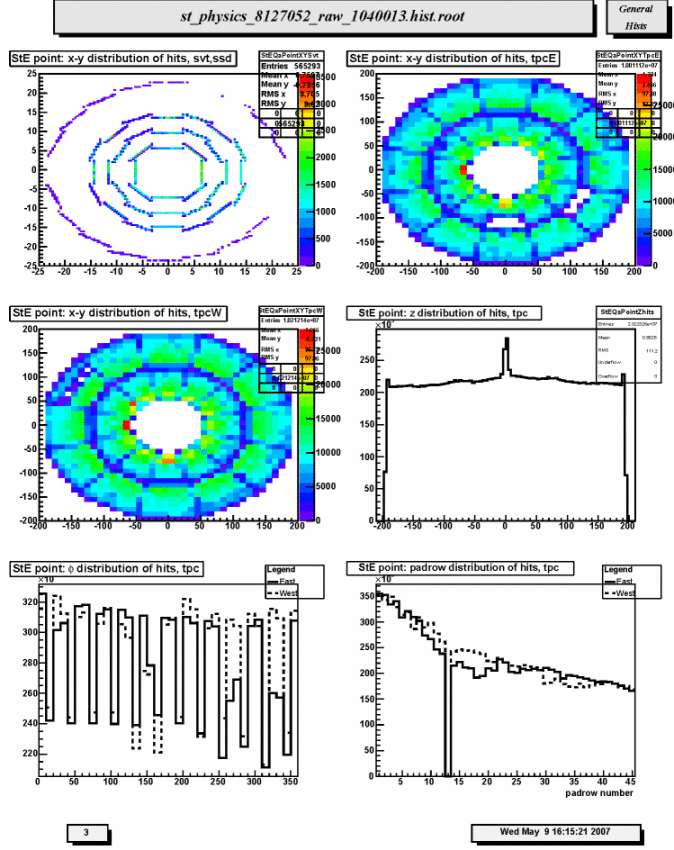
1. StE point: x-y distribution of hits, svt, ssd: Projection onto transverse
x-y plane of reconstructed space points in the SVT and SSD. The three
layers of the SVT and the outer SSD layer should be visible. Note any missing areas or persistent hot spots.
2. StE point: x-y distribution of hits, tpcE:
Scatter plot of the azimuthal distribution of reconstructed space points
in the East TPC. The distribution should be azimuthally uniform exept
for the 12 sector structure of the TPC (lighter areas indicate sector
boundaries). Density should decrease radially but inner and outer sector
structure should be present (darker areas in the innermost pads of the
inner and outer sectors). Watch for empty areas (typically masked RDOs)
and hot spots. Notify if new empty area or hot spot appears.
3. StE point: x-y distribution of hits, tpcW:
Scatter plot of the azimuthal distribution of reconstructed space points
in the West TPC. The distribution should be azimuthally uniform exept
for the 12 sector structure of the TPC (lighter areas indicate sector
boundaries). Density should decrease radially but inner and outer sector
structure should be present (darker areas in the innermost pads of the
innear and outer sectors). Watch for empty areas (typically masked RDOs)
and hot spots. Notify if new empty area or hot spot appears.
4. StE point: z distribution of hits, tpc:
Distribution of reconstructed space points in TPC with respect to
z-coordinate. Should be flat within statistics. Watch out for anamolous
peaks at z=0 (central membrane), steps or unusual spikes or dips. Some
roll-off at the ends is normal.
5. StE point: #phi distribution of hits, tpc:
Distribution of reconstructed space points in TPC with respect to
azimuthal coordinate (phi) for east (solid line) and west (dashed line)
halves. Should be flat except for the 12-fold sector structure or masked
RDOs (as shown). Dead RDO's will produce dips and gaps; hot pads or
FEE cards will produce spikes.
6. StE point: padrow distribution of hits, tpc:
Distribution of reconstructed space points in TPC with respect to padrow
number 1-45. Should display gradual fall-off; watch for anamolous spikes
and dips. Padrow 13 has been masked out and should be empty.
Page 4
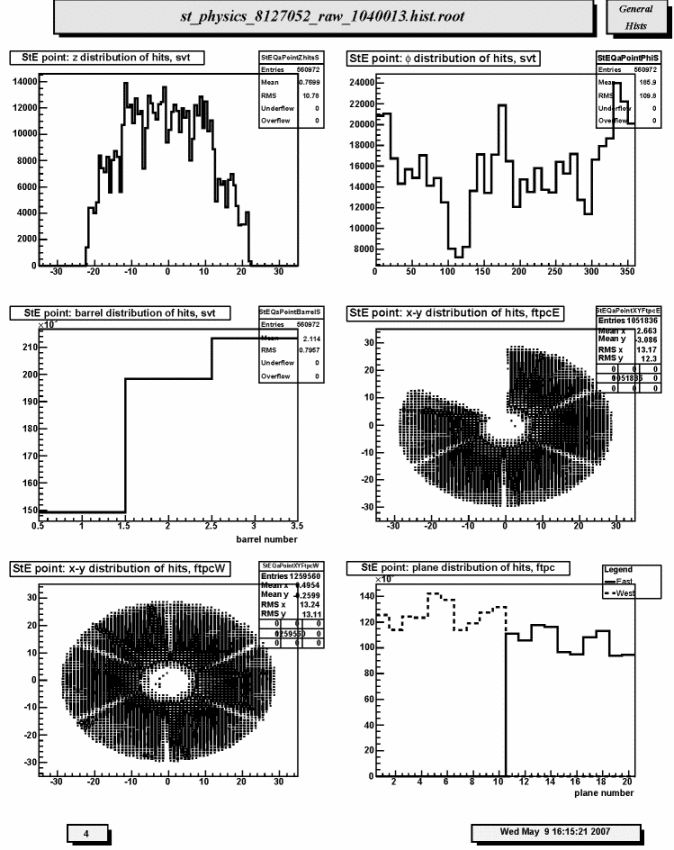
1. StE point: z distribution of hits, svt:
Distribution of reconstructed space points in SVT with respect to
z-coordinate. Should be flat within statistics with step like drop off
at larger abs(z) due to SVT barrel structure. Depends on distribution of
collision vertices.
2. StE point: #phi distribution of hits, svt:
Distribution of reconstructed space points in SVT with respect to
azimuthal coordinate (phi). Should be flat within statistics.
3. StE point: barrel distribution of hits, svt:
Distribution of reconstructed space points in SVT with respect to barrel
number 1-3. Should have larger number in outer 2 barrels than the first.
4. StE point: x-y distribution of hits, ftpcE:
Radial distribution of reconstructed space points in FTPC East. The distribution should be uniform
except for the insensitive gaps between the six readout sectors. Localized denser areas are due to noise.
Ideally noisy pads are flagged in the FTPC gain tables so that they are not used for cluster finding.
Less densely populated areas not on the sector boundaries are due to dead electronics. Empty areas
not on the sector boundaries indicates a serious hardware problem. An FTPC expert should be contacted
immediately if this is seen in fast offline-QA during data taking.
5. StE point: x-y distribution of hits, ftpcW:
Radial distribution of reconstructed space points in FTPC West. The distribution should be uniform except for the
insensitive gaps between the six readout sectors. Localized denser areas are due to noise. Ideally noisy pads are
flagged in the FTPC gain tables so that they are not used for cluster finding. Less densely populated areas not on
the sector boundaries are due to dead electronics. Empty areas not on the sector boundaries indicates a serious
hardware problem. An FTPC expert should be contacted immediately if this is seen in fast offline-QA during data taking.
6. StE point: plane distribution of hits, ftpc:
Number of reconstructed space points assigned to tracks in FTPC East (solid line) and West (dashed line) in each padrow.
The horizontal axis shows padrow numbers where FTPC-West is 1-10 and FTPC-East is 11-20. Padrows #1 and #11 are closest
to the center of STAR. East and West should be similar in shape and magnitude. Spikes indicate noisy electronics; dips
indicate dead electronics.
Page 5
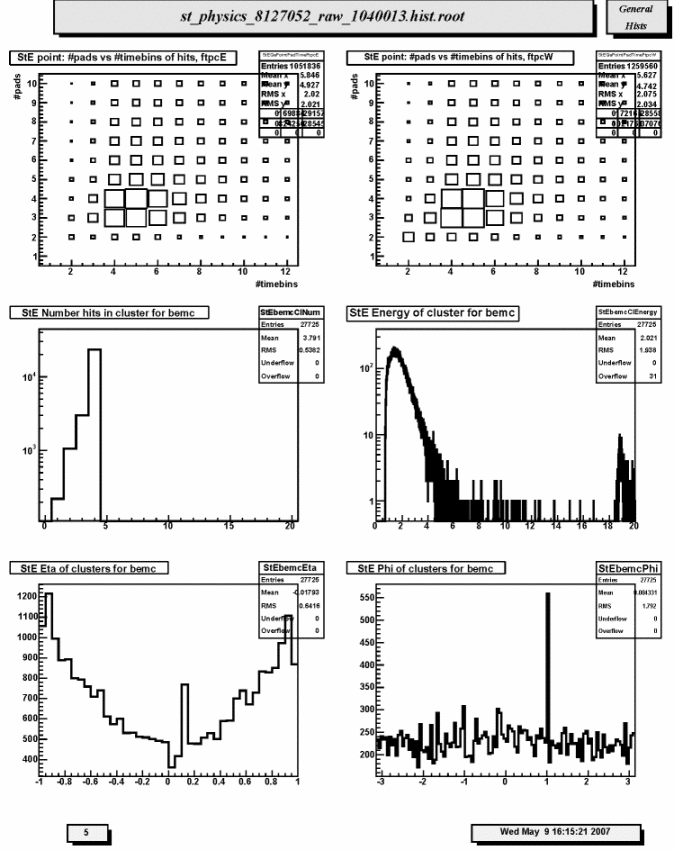
1. StE point: #pads vs #timebins of hits, ftpcE:
Monitors the cluster quality in FTPC East. Ideally the clusters should have a pad length of 3-5 and a timebin length
of 4-6. A prominent peak located at (2,2) indicates bad gas or loss of gain or excessive background.
2. StE point: #pads vs #timebins of hits, ftpcW:
Monitors the cluster quality in FTPC West. Ideally the clusters should have a pad length of 3-5 and a timebin length of 4-6.
A prominent peak located at (2,2) indicates bad gas or loss of gain or excessive background.
3. StE Number hits in cluster for bemc:
Distribution of number of BEMC towers contributing to energy clusters.
4. StE Energy of cluster for bemc:
Distribution of energy in reconstructed clusters in EMC barrel.
5. StE Eta of clusters for bemc:
Azimuthally integrated pseudorapidity distribution of reconstructed energy clusters
in the EMC-barrel. Note there will be gaps due to missing and/or
uninstrumented sectors. Report any unexpected gaps or unusual spikes.
For Run 7 the full barrel is instrumented. The distribution should nominally
be flat.
6. StE Phi of clusters for bemc:
Pseudorapidity integrated azimuthal distribution (radians) of reconstructed energy
clusters in the EMC-barrel. Note there will be gaps due to missing
and/or uninstrumented sectors. Report any unexpected gaps or unusual
spikes.
Page 6
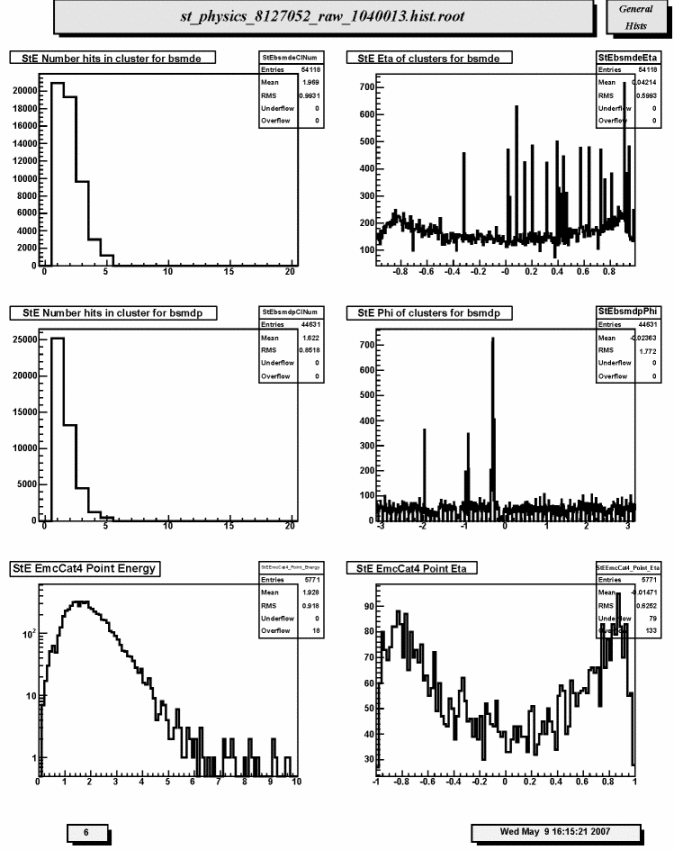
1. StE Number hits in cluster for bsmde:
Distribution of numbers of hits (anodes) contributing to Barrel SMD
clusters along pseudorapidity.
2. StE Eta of clusters for bsmde:
Pseudorapidity distribution of reconstructed energy clusters in the BSMD
anode grid along pseudorapidity. Note there will be gaps due to
missing and/or uninstrumented sectors. Report any unexpected gaps or
unusual spikes. Distribution should nominally be flat.
3. StE Number hits in cluster for bsmdp:
Distribution of numbers of hits (anodes) contributing to Barrel SMD
clusters along azimuth.
4. StE Phi of clusters for bsmdp:
Azimuthal distribution of reconstructed energy clusters in the BSMD
anode grid along azimuth angle (phi in radians). Note there will be gaps due to
missing and/or uninstrumented sectors. Report any unexpected gaps or
unusual spikes.
5. StE EmcCat4 Point Energy:
Energy distribution for Barrel EMC-SMD Category 4 clusters. Cat4
clusters correspond to TPC track matched clusters in the EMC barrel,
BSMD-eta and BSMD-phi detectors.
6. StE EmcCat4 Point Eta:
Pseudorapidity distribution for EMC-SMD Category 4 clusters. Distribution should nominally be flat.
Page 7
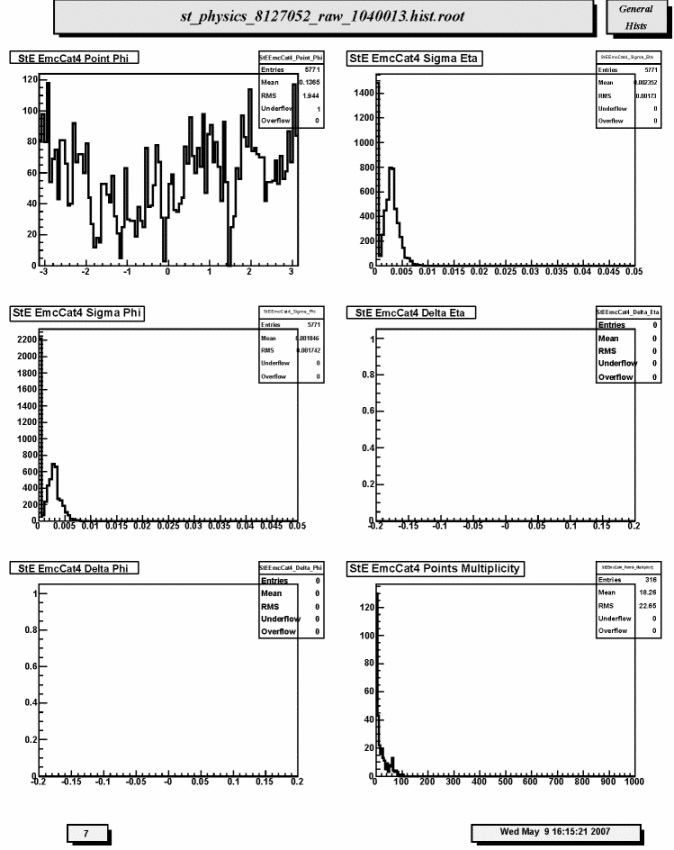
1. StE EmcCat4 Point Phi:
Azimuthal distribution for EMC-SMD Category 4 clusters.
2. StE EmcCat4 Sigma Eta:
Distribution of widths (sigma) of Category 4 Barrel EMC-SMD clusters
with respect to pseudorapidity.
3. StE EmcCat4 Sigma Phi:
Distribution of widths (sigma) of Category 4 Barrel EMC-SMD clusters
with respect to azimuthal angle.
4. StE EmcCat4 Delta Eta:
Differences between centroids of Category 4 Barrel EMC-SMD clusters and
projected positions of TPC tracks at BEMC with respect to
pseudorapidity. Should be peaked at ~0.
5. StE EmcCat4 Delta Phi:
Differences between centroids of Category 4 Barrel EMC-SMD clusters and
projected positions of TPC tracks at BEMC with respect to azimuthal
angle. Should be peaked at ~0.
6. StE EmcCat4 Points Multiplicity:
Frequency distribution of number of Category 4 clusters per event.
Page 8
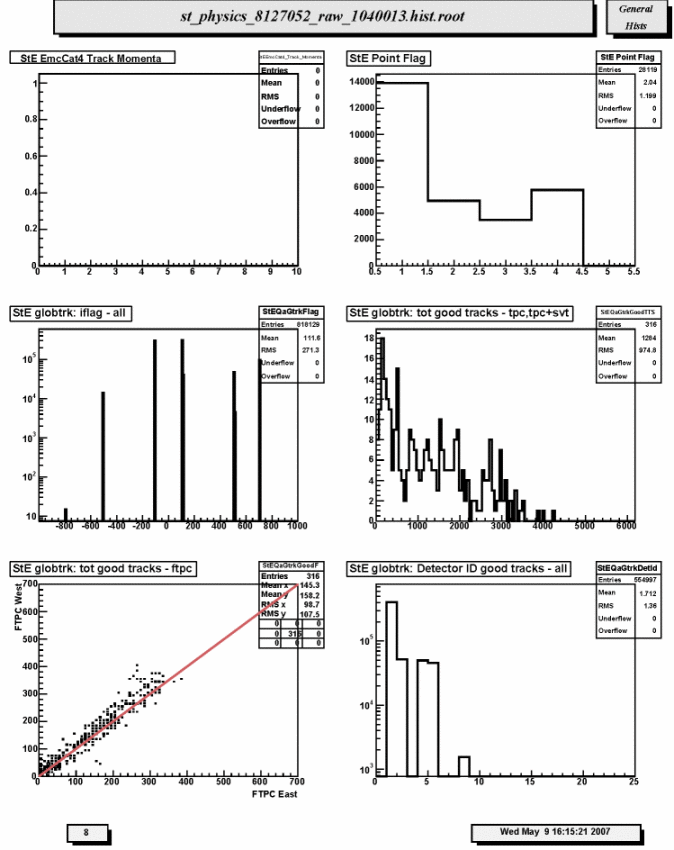
1. StE EmcCat4 Track Momenta :
Distribution of TPC global track momentum for Barrel EMC-SMD Category 4
clusters.
2. StE Point Flag:
Distribution of Barrel EMC and SMD cluster types by Category number.
There should be a reasonable fraction of Cat4 clusters; report if
less than 10% of total.
3. StE globtrk: iflag - all :
Quality flag values for all global tracks. Some with large, negative
values may not appear on plot; check stat. box for underflows. Majority
of tracks should have iflag>0, corresponding to good, usable tracks.
Refer to: dst_track_flags.html and kalerr.html for description of flag
values. Note that in Run 7 about half the tracks have iflag < 0 for
unknown reasons.
4. StE globtrk: tot good tracks - tpc,tpc+svt:
Global track multiplicity distribution for TPC-only and SVT+TPC tracks.
Magnitude and width depends on trigger condition or multiplicity cuts.
5. StE globtrk: tot good tracks - ftpc:
Scatter plot of good global track multiplicities in FTPC West versus
FTPC East. Distribution should be correlated and lie along the reference
diagonal line, depending on the relative fraction of active readout in
the East and West detectors. Magnitudes and widths depend on trigger
condition or multiplicity cuts.
6. StE globtrk: Detector ID good tracks - all:
Global track detector IDs for good tracks. Refer to:
/afs/rhic/star/packages/DEV00/pams/global/inc/StDetectorDefinitions.h
for Detector ID codes.
Page 9
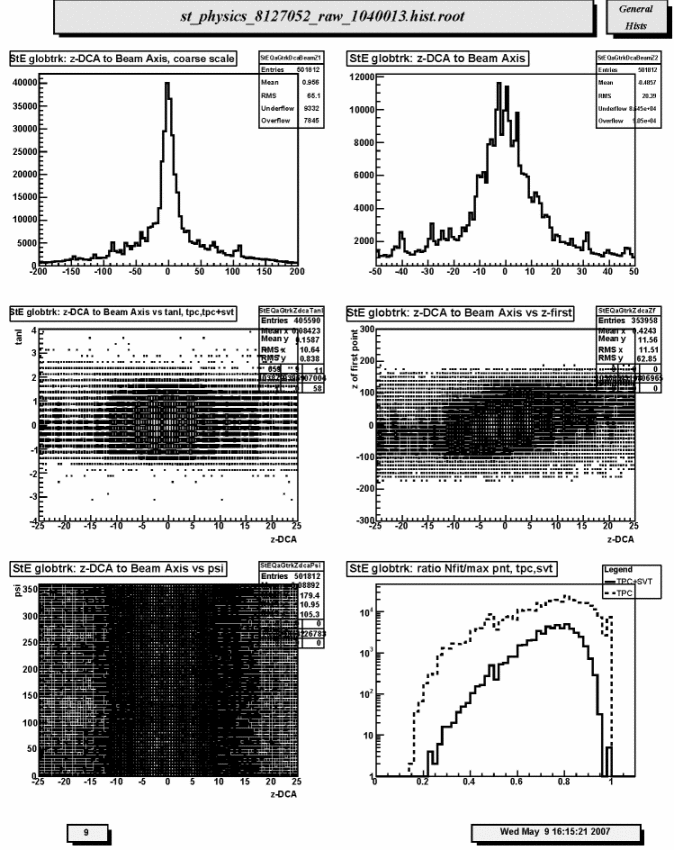
1. StE globtrk: z-DCA to Beam Axis, coarse scale:
Coarse scale distribution along the z-axis (from -200 to +200 cm) of the
DCA points to the nominal beam line (z-axis, x=y=0) for all TPC and
SVT+TPC global tracks. Peaks indicate probable locations of individual
collision vertices. There should be many peaks corresponding to the RHIC
beam-beam collision region. Indentification of individual collision
vertices is unlikely.
2. StE globtrk: z-DCA to Beam Axis:
Fine scale distribution along the z-axis (from -50 to +50 cm) of the DCA
points to the nominal beam line (z-axis, x=y=0) for all TPC and SVT+TPC
global tracks. Peaks indicate probable locations of individual collision
vertices. Peaks near the center should be narrower than those beyond
about 25 cm due to variations in the effective radiation thickness of
the SVT assembly along the z-axis. Indentification of individual collision
vertices is unlikely.
3. StE globtrk: z-DCA to Beam Axis vs tanl, tpc,tpc+svt:
Scatter plot of the tangent of the dip angle (tanl) versus the
z-coordinate (from -25 to 25 cm) of the DCA points to the nominal beam
line (z-axis, x=y=0) for all TPC and SVT+TPC global tracks. Vertical
bands should be seen corresponding to individual events. The bands
should be smooth and continuous; breaks at tanl=0 indicate probable TPC
calibration errors in either the t0 offset or the drift speed. This is best seen for high multiplicity events.
Cross reference for calibration errors with z-DCA to beam axis versus
z-coord. of first hit on track.
4. StE globtrk: z-DCA to Beam Axis vs z-first:
Scatter plot of the z-coordinate of the first fitted hit in the TPC
versus the z-coordinate (from -25 to 25 cm) of the DCA points to the
nominal beam line (z-axis, x=y=0) for all TPC-only global tracks and
SVT+TPC global tracks in which the first point used in the fit lies in
the TPC (i.e. SVT assigned hits are thrown out during the fitting
process). Vertical bands should be seen corresponding to individual
events. The bands should be smooth and continuous; breaks at z=0
indicate TPC calibration errors in either the t0 offset or the drift
speed. This is best seen for high multiplicity events. This plot is of
limited value compared to the previous due to the SVT which catches most
of the first hits.
5. StE globtrk: z-DCA to Beam Axis vs psi:
Scatter plot of the azimuthal direction angle (psi) versus the
z-coordinate (from -25 to 25 cm) of the DCA points to the nominal beam
line (z-axis, x=y=0) for all TPC and SVT+TPC global tracks. Vertical
bands should be seen corresponding to individual events. The bands
should be smooth, straight and continuous indicating azimuthal symmetry
in the tracking. Bends or offsets could indicate problems in individual
TPC sectors such as voltage sags or drifts. These are best studied with
high multiplicity events.
6. StE globtrk: ratio Nfit/max pnt, tpc,svt:
Ratio of number of fitted points to estimated maximum number for
TPC-only (dashed line) and SVT+TPC (solid line) global tracks. Peak at
low value indicates track splitting. Ratio for SVT+TPC global tracks
should peak near 1.
Page 10
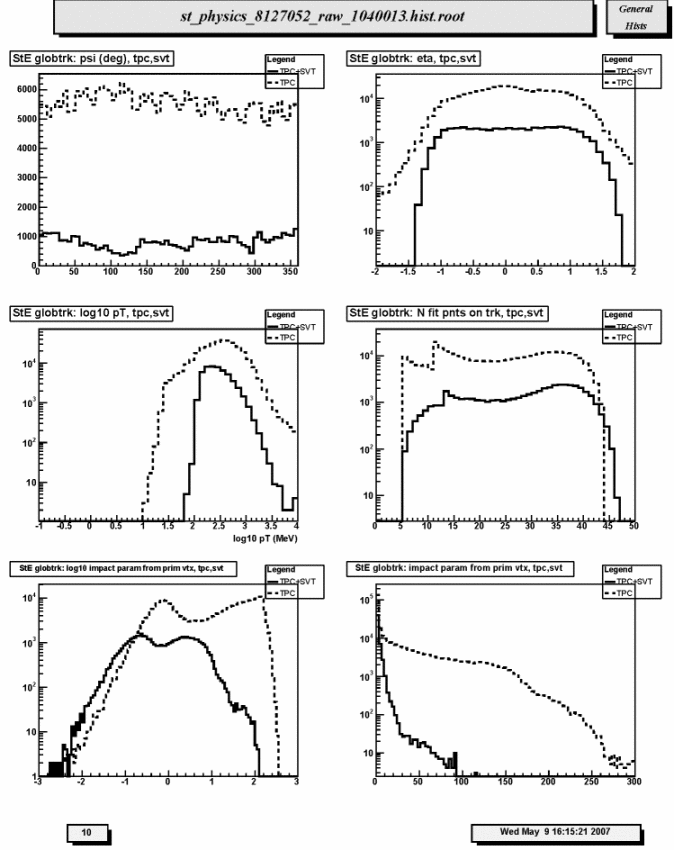
1. StE globtrk: psi (deg), tpc,svt:
Azimuthal distributions for track direction angle (psi) for TPC-only
(dashed line) and SVT+TPC (solid line) global tracks. Should be flat
within statistics, except for the 12-sector structure in the TPC-only
global tracks.
2. StE globtrk: eta, tpc,svt:
Pseudorapidity (eta) distributions for TPC-only (dashed line) and
SVT+TPC (solid line) global tracks. TPC track distribution should be
symmetric about eta=0. SVT+TPC track distribution may be non-symmetric
depending on the distribution of primary vertices.
3. StE globtrk: log pT, tpc,svt:
Log-base-10 transverse momentum (GeV/c) distributions for TPC-only
(dashed line) and SVT+TPC (solid line) global tracks.
4. StE globtrk: N fit pnts on trk, tpc,svt:
Distribution of the number of fitted points on track for TPC-only
(dashed line) and SVT+TPC (solid line) global tracks. Peak at low value
indicates track splitting. Should see an increase near ~40.
5. StE globtrk: log10 impact param from prim vtx, tpc,svt:
Log-base-10 plot of impact parameter (in cm) from primary vertex for
TPC-only (dashed line) and SVT+TPC (solid line) global tracks. SVT+TPC
tracks should have much smaller impact parameter values.
6. StE globtrk: impact param from prim vtx, tpc,svt:
Linear plot of impact parameter (in cm) from primary vertex for TPC-only
(dashed line) and SVT+TPC (solid line) global tracks. SVT+TPC tracks
should have much smaller impact parameter values.
Page 11
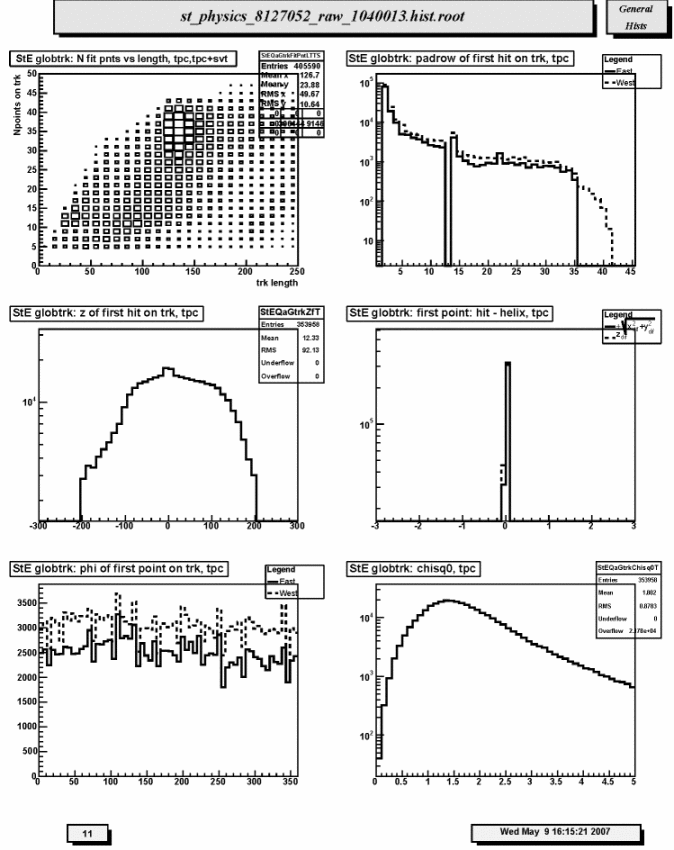
1. StE globtrk: N fit pnts vs length, tpc,tpc+svt:
Scatter plot of number of fitted points on track versus track length
(from first to last point along helical path) for both TPC-only and
SVT+TPC global tracks. Peak in lower left corner indicates split tracks.
There should be some increase for >30 points and lengths from 1 - 2 m.
2. StE globtrk: padrow of first hit on trk, tpc:
Distribution of first fitted space point with respect to pad row number
for TPC-only global tracks. Should peak at 1 with a minor peak at padrow
14 (beginning of outer sector); the latter should not be too big
relative to that at row 1. Other peaks may indicate large, missing
sections of the TPC read-out causing breaks, and consequently
additional, false new starting points for tracks. Padrow 13 is masked out.
3. StE globtrk: z of first hit on trk, tpc:
Distribution of first fitted space point with respect to z for TPC-only
global tracks. Should be approx. symmetric and flat around z=0. A peak
or hole at z=0 may indicate TPC calibration errors in either the t0
offset or the drift speed. Cross reference for calibration errors with z-DCA vs tan1.
4. StE globtrk: first point: hit - helix, tpc:
Residuals at FIRST point on track for TPC-only global tracks. The
quantities plotted are the longitudinal (along z-axis, dashed line) and
transverse (in x-y plane, solid line) differences between the
coordinates of the first hit and the DCA point on the helix fit to the
first point. For the transverse residual, positive (negative) values
correspond to hits inside (outside) the circular projection of the helix
onto the bend plane. FWHM should be less than ~ 1cm.
5. StE globtrk: phi of first point on trk, tpc:
Distribution of first fitted space point with respect to azimuthal angle
(phi) for TPC-only global tracks. The solid (dashed) line is for the
east (west) half of the TPC. These should be approximately equal and
flat within statistics, except for the 12-sector structure.
6. StE globtrk: chisq0, tpc:
Chi-square per degree of freedom for TPC global tracks. Should peak just below 1.
Page 12
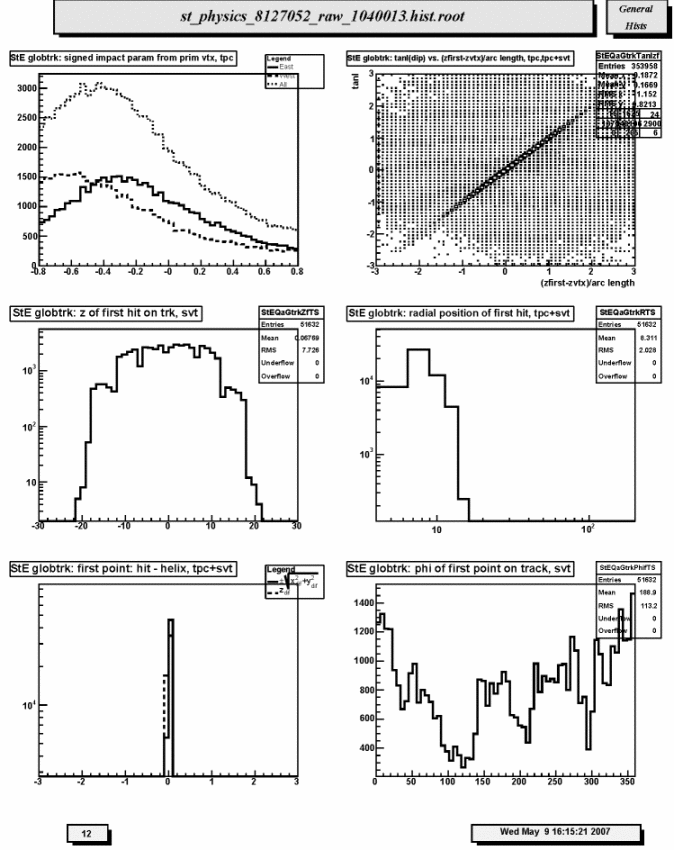
1. StE globtrk: signed impact param from prim vtx, tpc:
Two-dimensional (2D) (in the transverse plane) signed impact parameter
(in cm) from primary vertex for East (solid line), West (dashed line)
and All (dotted line) TPC-only global tracks. Should be centered at
zero.
2. StE globtrk: tanl(dip) vs. (zfirst-zvtx)/arc length, tpc,tpc+svt:
Scatter plot of tangent of dip angle (tanl) versus (z_first -
z_primvrtx)/arc-length for TPC-only global tracks and SVT+TPC global
tracks whose first fitted point is in the TPC. Variable 'z_first' is the
z coordinate of the first fitted point in the TPC. Variable 'z_primvrtx'
is the z-coordinate of the primary vertex for the event. Variable
'arc-length' is 2R*arcsin(delta_r/2R) where R = track radius of
curvature and delta_r is the transverse distance between the primary
vertex and the first hit on track. Primary tracks lie along the 45 deg
diagonal. Secondary tracks and strays lie scattered to either side. The
diagonal band should appear clearly and be straight and smooth without
kinks, breaks or bends.
3. StE globtrk: z of first hit on trk, svt:
Distribution of first fit hits with respect to z for SVT+TPC global
tracks which have the first fitted hit in the SVT. Should be flat within
statistics but could display steps at the ends due to the SVT layers.
Should be approximately symmetric but depends on distribution of primary
vertices.
4. StE globtrk: radial position of first hit, tpc+svt:
Distribution of radial position of first fitted hits on SVT+TPC global
tracks.
5. StE globtrk: first point: hit - helix, tpc+svt:
Residuals at FIRST point on track for SVT+TPC global tracks. The
quantities plotted are the longitudinal (along z-axis, dashed line) and
transverse (in x-y plane, solid line) differences between the
coordinates of the first hit and the DCA point on the helix fit to the
first point. For the transverse residual, positive (negative) values
correspond to hits inside (outside) the circular projection of the helix
onto the bend plane. FWHM should be less than ~ 0.1 cm.
6. StE globtrk: phi of first point on track, svt:
Distribution of first fitted space point with respect to azimuthal angle
(phi) for SVT+TPC global tracks with first point in the SVT. These
should be approximately equal and flat within statistics.
Page 13
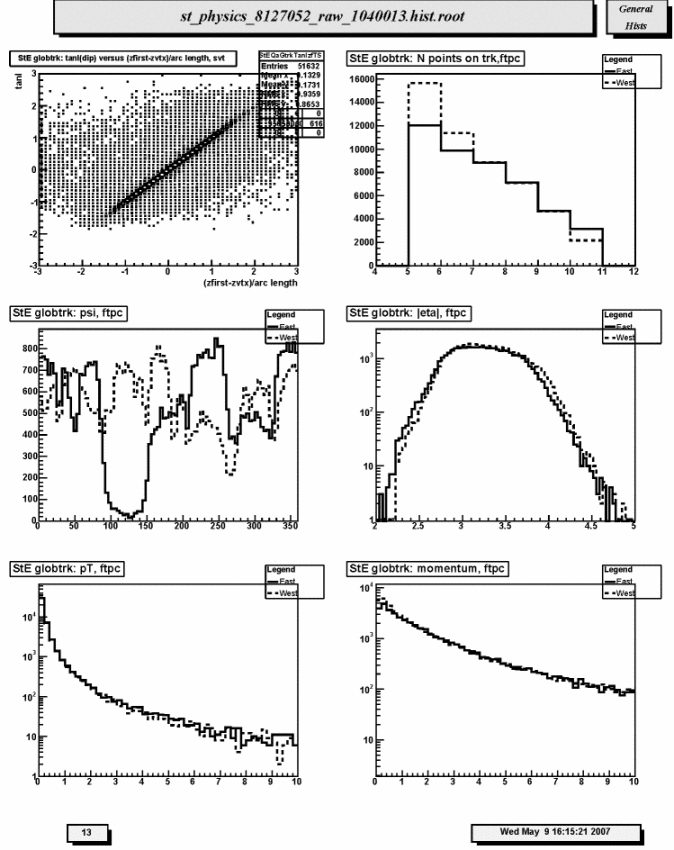
1. StE globtrk: tanl(dip) versus (zfirst-zvtx)/arc length, svt:
Scatter plot of tangent of dip angle (tanl) versus (z_first -
z_primvrtx)/arc-length for global tracks with SVT hits. Variable 'z_first' is the
z coordinate of the first fitted point in the SVT. Variable 'z_primvrtx'
is the z-coordinate of the primary vertex for the event. Variable
'arc-length' is 2R*arcsin(delta_r/2R) where R = track radius of
curvature and delta_r is the transverse distance between the primary
vertex and the first hit on track. Primary tracks lie along the 45 deg
diagonal. Secondary tracks and strays lie scattered to either side. The
diagonal band should appear clearly and be straight and smooth without
kinks, breaks or bends.
2. StE globtrk: N points on trk,ftpc:
Distribution of the number of fitted points on track for FTPC-East
(solid line) and FTPC-West (dashed line) global tracks. Distributions
should be similar within statistics, depending on the relative fraction
of active readout in each detector.
3. StE globtrk: psi, ftpc:
Azimuthal distributions for track direction angle (psi) for FTPC-East
(solid line) and FTPC-West (dashed line) global tracks. These should be
similar and flat within statistics except for the hexagonal FTPC sector
structure.
4. StE globtrk: |eta|, ftpc:
Distributions of absolute value of pseudorapidity for FTPC-East (solid
line) and FTPC-West (dashed line) global tracks. These should be similar
within statistics and range from about 2.5 to 4.5.
5. StE globtrk: pT, ftpc:
Transverse momentum (GeV/c) distributions for FTPC-East (solid line) and
FTPC-West (dashed line) global tracks. These should be similar within
statistics.
6. StE globtrk: momentum, ftpc:
Total momentum (GeV/c) distributions for FTPC-East (solid line) and
FTPC-West (dashed line) global tracks. These should be similar within
statistics.
Page 14
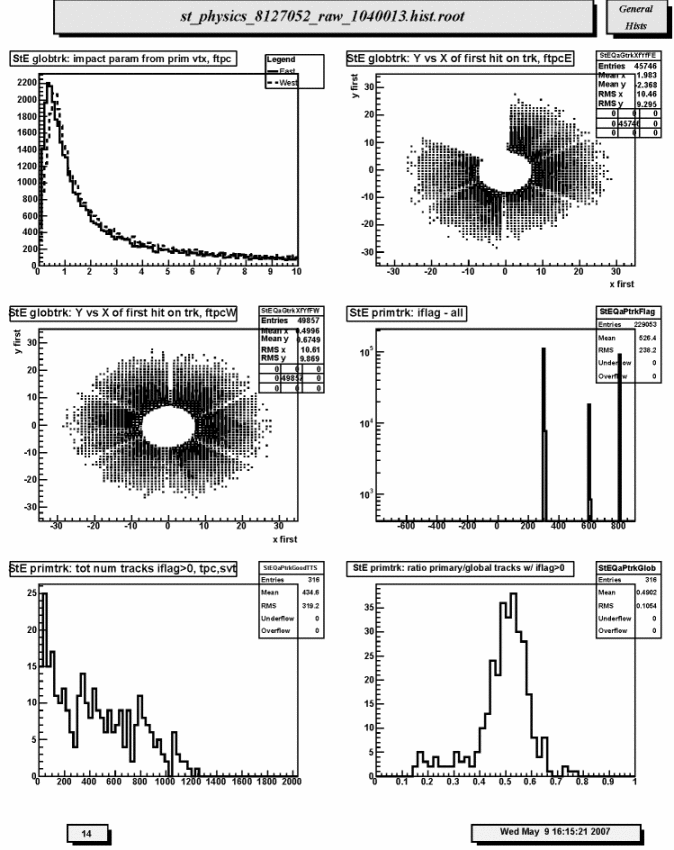
1. StE globtrk: impact param from prim vtx, ftpc:
Distribution of impact parameter values for global FTPC East tracks
(solid curve) and West tracks (dashed curve) with respect to the main
TPC global track determined primary vertex.
2. StE globtrk: Y vs X of first hit on trk, ftpcE:
Scatter plot of (x,y) coordinates for the first fitted space points in
FTPC-East global tracks. These should be uniformly populated with hits;
FTPC hexagonal structure is apparent.
3. StE globtrk: Y vs X of first hit on trk, ftpcW:
Scatter plot of (x,y) coordinates for the first fitted space points in
FTPC-West global tracks. These should be uniformly populated with hits;
FTPC hexagonal structure is apparent.
4. StE primtrk: iflag - all:
Quality flag values for all primary tracks. Some with large, negative
values may not appear on plot; check stat. box for underflows. Majority
of tracks should have iflag>0, corresponding to good, usable tracks.
Refer to: dst_track_flags.html and kalerr.html for description of flag
values.
5. StE primtrk: tot num tracks iflag>0, tpc,svt:
Good primary track multiplicity distribution for TPC-only and SVT+TPC
tracks. Magnitude and width depends on trigger condition or multiplicity cuts.
6. StE primtrk: ratio primary/global tracks w/ iflag>0:
Ratio of good primary to good global tracks for all detectors. Should be
of order 1/2.
Page 15
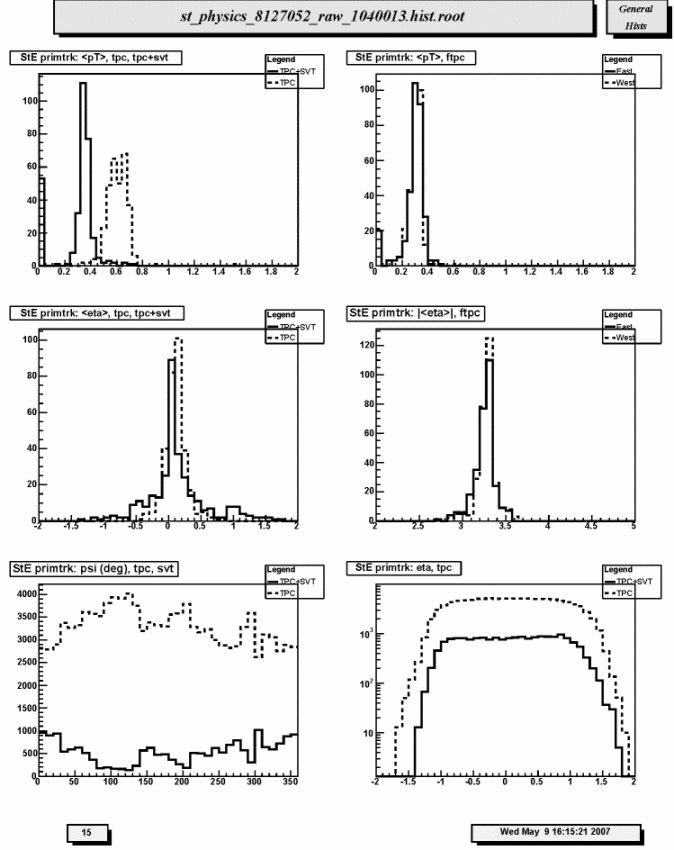
1. StE primtrk: , tpc, tpc+svt:
Mean transverse momentum distribution for TPC-only (dashed line) and
SVT+TPC (solid line) good primary tracks. Should peak around 0.4 - 0.6
GeV/c and be fairly narrow. Report double peaks.
2. StE primtrk: , ftpc:
Transverse momentum (GeV/c) distributions for FTPC-East (solid line) and
FTPC-West (dashed line) primary tracks. These should be similar within
statistics.
3. StE primtrk: , tpc, tpc+svt:
Mean pseudorapidity distribution for TPC-only (dashed line) and SVT+TPC
(solid line) good primary tracks. Should peak around 0 but can be fairly
broad depending on distribution of primary vertices.
4. StE primtrk: ||, ftpc:
Distributions of absolute value of pseudorapidity for FTPC-East (solid
line) and FTPC-West (dashed line) primary tracks. These should be
similar within statistics and range from about 2.5 to 4.5.
5. StE primtrk: psi (deg), tpc, svt:
Azimuthal distributions for primary track direction angle (psi) for TPC-only
(dashed line) and SVT+TPC (solid line) good primary tracks. Should be
flat within statistics but may show the TPC sector gaps.
6. StE primtrk: eta, tpc:
Pseudorapidity (eta) distributions for TPC-only (dashed line) and
SVT+TPC (solid line) primary tracks. TPC tracks should be symmetric
about eta=0. SVT+TPC may have slight non-symmetry depending on
distribution of primary vertices.
Page 16
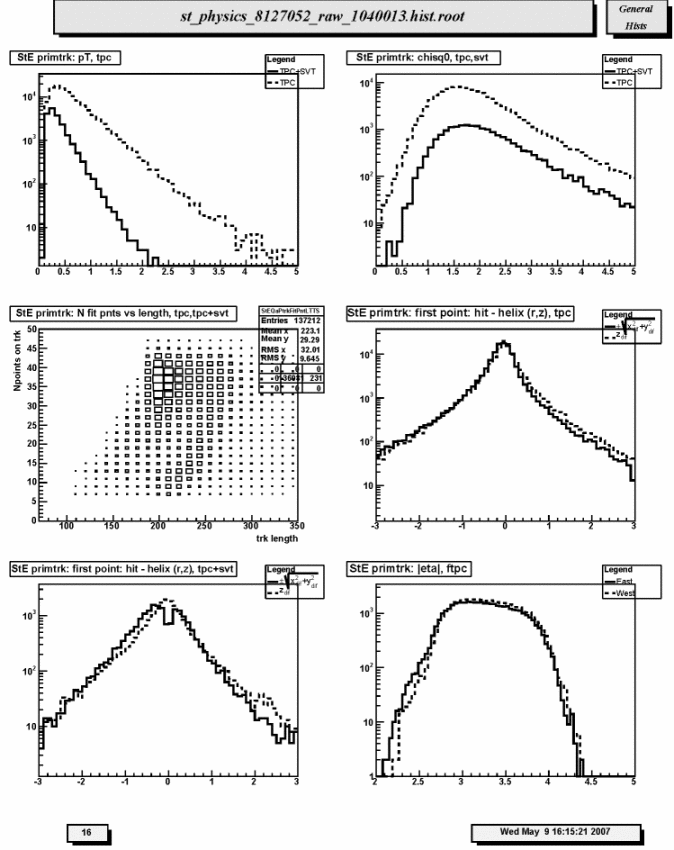
1. StE primtrk: pT, tpc:
Transverse momentum (GeV/c) distributions for TPC-only (dashed line) and
SVT+TPC (solid line) primary tracks.
2. StE primtrk: chisq0, tpc,svt:
Chi-square per degree of freedom for TPC-only (dashed line) and SVT+TPC
(solid line) primary tracks. Both should peak just below 1, but watch
for anomalously long tails at large chi-square.
3. StE primtrk: N fit pnts vs length, tpc,tpc+svt:
Scatter plot of number of fitted points on primary tracks versus track length
(from first to last point along helical path) for both TPC-only and
SVT+TPC primary tracks. There should not be a peak in lower left corner
indicating fewer split tracks than for global tracks. There should be a
peak(s) for long tracks above 1.5 m.
4. StE primtrk: first point: hit - helix (r,z), tpc:
Residuals at first point on track for TPC-only primary tracks. The
quantities plotted are the longitudinal (along z-axis, dashed line) and
transverse (in x-y plane, solid line) differences between the
coordinates of the first hit and the DCA point on the helix fit to the
first point. For the transverse residual, positive (negative) values
correspond to hits inside (outside) the circular projection of the helix
onto the bend plane. FWHM should be less than ~ 1cm.
5. StE primtrk: first point: hit - helix (r,z), tpc+svt:
Residuals at first point on track for SVT+TPC primary tracks. The
quantities plotted are the longitudinal (along z-axis, dashed line) and
transverse (in x-y plane, solid line) differences between the
coordinates of the first hit and the DCA point on the helix fit to the
first point. For the transverse residual, positive (negative) values
correspond to hits inside (outside) the circular projection of the helix
onto the bend plane. FWHM should be less than ~ 0.1 cm.
6. StE primtrk: |eta|, ftpc:
Distributions of absolute value of pseudorapidity for FTPC-East (solid
line) and FTPC-West (dashed line) primary tracks. These should be
similar within statistics and range from about 2.5 to 4.5.
Page 17
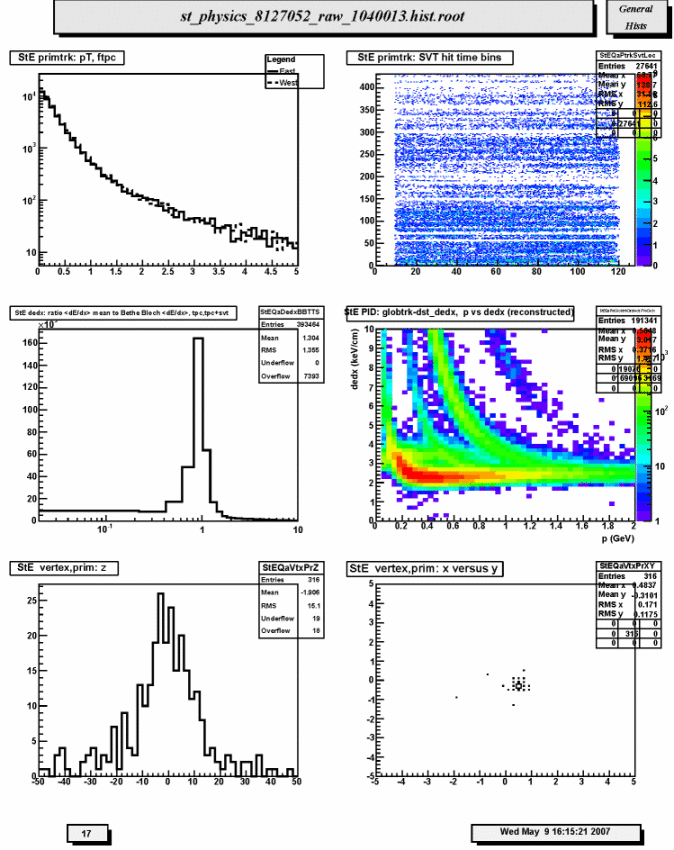
1. StE primtrk: pT, ftpc:
Transverse momentum (GeV/c) distributions for FTPC-East (solid line) and
FTPC-West (dashed line) primary tracks. These should be similar within
statistics.
2. StE primtrk: SVT hit time bins:
Distribution of SVT hits on time bin (x-axis) and hybrid board number (y-axis).
Horizontal gaps indicate electronics outages or masked off channels. Data
points should not extend below time bin = 10 or above 120. Report data
runs with data in these left and/or right margins or when new missing horizontal
gaps appear.
3. StE dedx: ratio mean to Bethe Bloch , tpc,tpc+svt:
Distribution of ratio of mean dE/dx to Bethe-Bloch dE/dx for pions at
the same momentum for TPC-only and SVT+TPC global tracks. Should peak at
~1. Tests calibration of charge deposition in TPC gas.
4. StE PID: globtrk-dst_dedx, p vs dedx (reconstructed):
Scatter plot of truncated mean dE/dx versus total momentum (GeV/c) for
TPC-only and SVT+TPC global tracks. Should be able to see Bethe-Bloch
bands for pions, kaons and protons if statistics are sufficient.
5. StE vertex,prim: z :
Distribution of primary vertex position along the z-axis out to abs(z) <
50 cm.
6. StE vertex,prim: x versus y:
Scatter plot of the (x,y) coordinates of the primary vertex position.
This should correspond to the determined beam transverse position. The
amount of dispersion will depend on the trigger condition and
multiplicity cuts.
Page 18
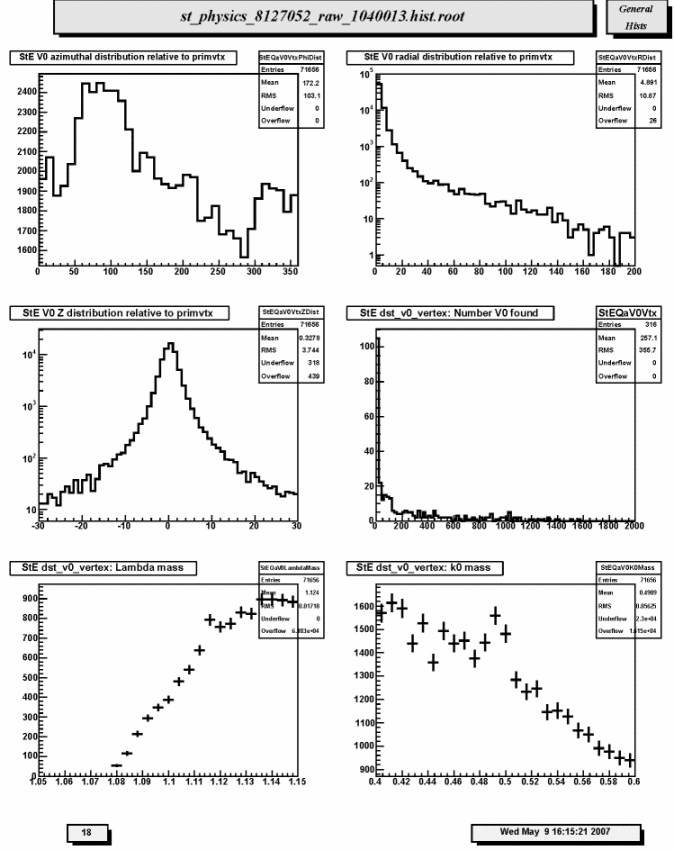
1. StE V0 azimuthal distribution relative to primvtx:
Azimuthal distribution of V0 vertices relative to the primary vertex for
each event. Should be flat within statistics.
2. StE V0 radial distribution relative to primvtx:
Radial distribution of V0 vertices relative to the primary vertex for
each event. Should fall off steeply with most vertices within ~10 cm.
3. StE V0 Z distribution relative to primvtx:
Longitudinal (z) distribution of V0 vertices relative to the primary
vertex for each event. Should fall off steeply with most vertices within
~10 cm.
4. StE dst_v0_vertex: Number V0 found :
Total number of V0 vertices found in each event; should scale with
multiplicity. Range depends on trigger condition and multiplicity cuts.
5. StE dst_v0_vertex: Lambda mass:
Invariant mass plot of V0 vertices using Lambda decay hypothesis.
It may be possible to see the Lambda peak.
6. StE dst_v0_vertex: k0 mass:
Invariant mass plot of V0 vertices using K0-short decay hypothesis.
It may be possible to see the K0-short peak.
Page 19
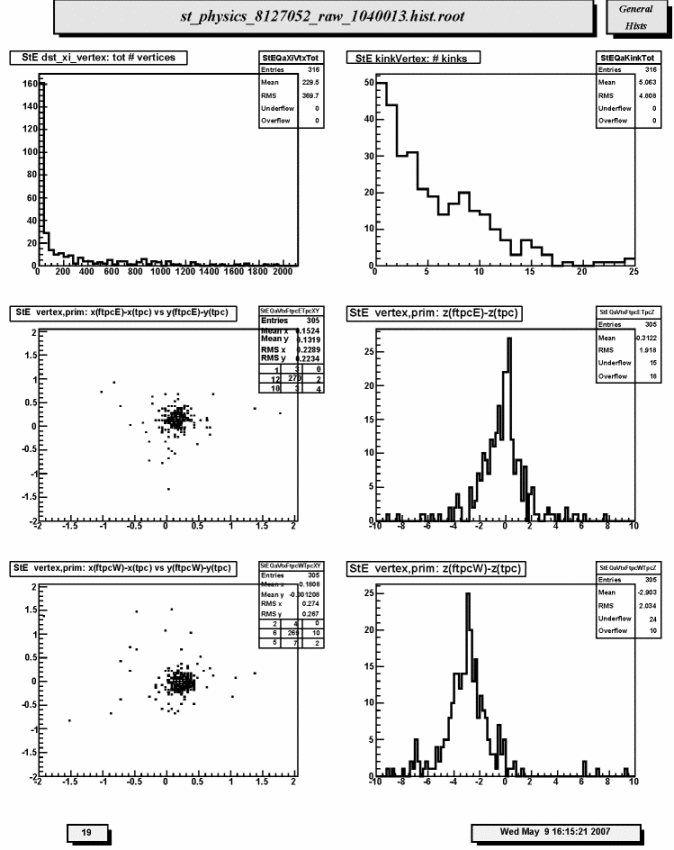
1. StE dst_xi_vertex: tot # vertices:
Total number of Xi vertex candidates found in each event; should scale
with multiplicity. Range depends on trigger condition and multiplicity
cuts.
2. StE kinkVertex: # kinks :
Total number of kink decay vertex candidates found in the TPC for
each event; should scale with multiplicity. Range depends on trigger
condition and multiplicity cuts.
3. StE vertex,prim: x(ftpcE)-x(tpc) vs y(ftpcE)-y(tpc):
Scatter plot of the differences in x-y position (cm) for primary vertex
positions determined by FTPC East global tracks and main TPC glbtrks.
Should scatter about (0,0).
4. StE vertex,prim: z(ftpcE)-z(tpc):
Distribution of the differences along the z-axis, i.e. beam direction,
in cm for primary vertex positions determined by FTPC East global
tracks and main TPC glbtrks. The mean should be near 0.
5. StE vertex,prim: x(ftpcW)-x(tpc) vs y(ftpcW)-y(tpc):
Scatter plot of the differences in x-y position (cm) for primary vertex
positions determined by FTPC West global tracks and main TPC glbtrks.
Should scatter about (0,0).
6. StE vertex,prim: z(ftpcW)-z(tpc):
Distribution of the differences along the z-axis, i.e. beam direction,
in cm for primary vertex positions determined by FTPC West global
tracks and main TPC glbtrks. The mean should be near 0.


















